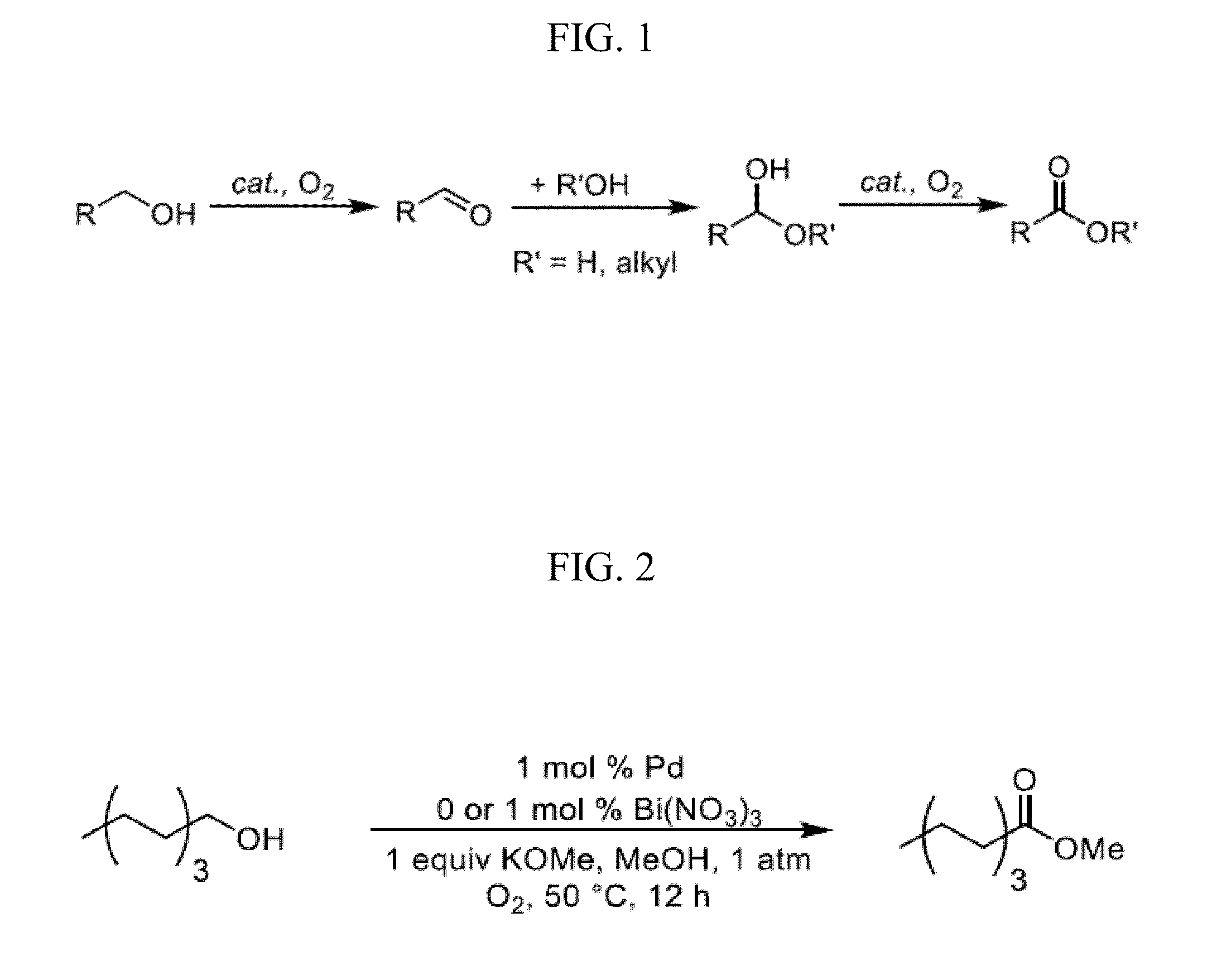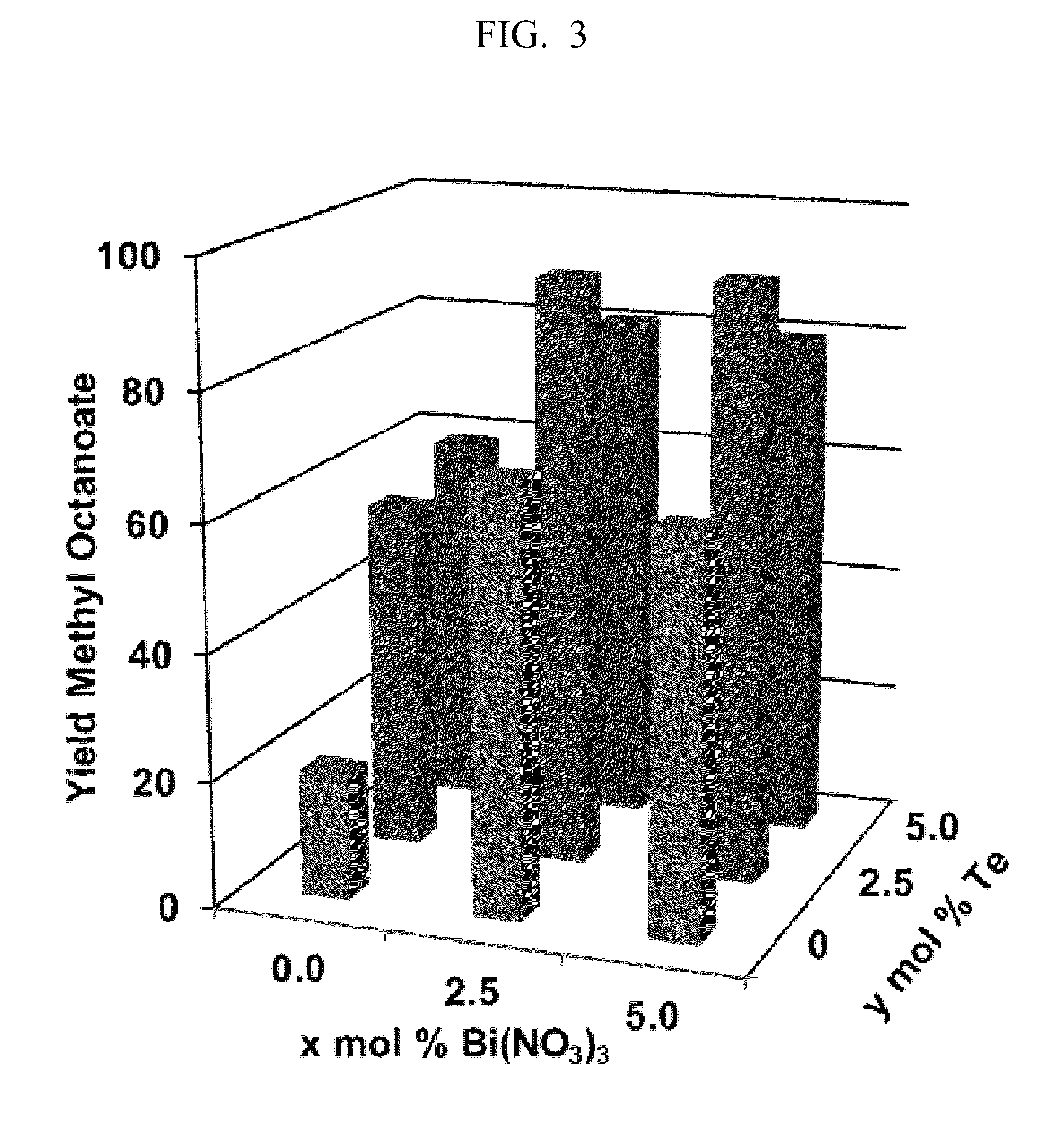Conversion Of Alcohols To Alkyl Esters And Carboxylic Acids Using Heterogeneous Palladium-Based Catalysts
a technology of alkyl esters and carboxylic acids, which is applied in the direction of catalyst activation/preparation, metal/metal-oxide/metal-hydroxide catalysts, physical/chemical process catalysts, etc., can solve the problems of difficulty in oxidation of aldehydes to corresponding carboxylic acids, limited substrate scope of primary alcohol oxidation methods, and low atom efficiency, so as to promote efficient aerobic oxidation of primary alcohols, improve the efficiency of selectivity
- Summary
- Abstract
- Description
- Claims
- Application Information
AI Technical Summary
Benefits of technology
Problems solved by technology
Method used
Image
Examples
example 1
PdBiTe Catalysts for Aerobic Oxidative Esterification of Primary Alcohols
[0121]This example highlights the potential of “admixture screening” as an efficient method for the discovery of new heterogeneous catalyst compositions, and the method is illustrated in the development of robust heterogeneous Pd catalysts for aerobic oxidative methyl esterification of primary alcohols. The identification of possible catalysts for this reaction was initiated by the screening of simple binary and ternary admixtures of Pd / charcoal in combination with one or two metal and / or metalloid components as the catalyst. This approach permitted rapid evaluation of over 400 admixture combinations for the oxidative methyl esterification of 1-octanol at 60° C. in methanol. Product yields from these reactions varied widely, ranging from 2-88%. The highest yields were observed with Bi-, Te and Pb-based additives, and particularly from those containing both Bi and Te. Validation of the results was achieved by pr...
example 1 references
CITED
[0177](1) Sheldon, R. A.; Bekkum, H. v., Fine Chemicals through Heterogeneous Catalysis, 2007, DOI: 10.1002 / 9783527612963[0178](2) Twigg, M. V., Catalyst Handbook, 2nd ed.; Wolfe Publishing Ltd: Frome, 1989.[0179](3) (a) Lindlar, H. Helv. Chim. Acta 1952, 35, 446. (b) Lindlar, H.; Dubuis, R. Org. Synth. 1966, 46, 89.[0180](4) (a) Stiles, A. B., Catalyst Manufacture: Laboratory and Commercial Preparation. In Chemical Industries; Marcel Dekker, Inc: New York, 1983; Vol. 14. (b) Farrauto, R. J.; Bartholomew, C. H., Fundamentals of Industrial Catalytic Processes, Chapman & Hall: Ney York, 1997.[0181](5) Hagemeyer, A.; Volpe, A. F., Modern Applications of High Throughput R&D in Heterogeneous Catalysis, 2014, DOI: 10.2174 / 97816080587231140101.[0182](6) For representative primary references, see: (a) Liu, Y.; Cong, P.; Doolen, R. D.; Guan, S.; Markov, V.; Woo, L.; ZeyB, S.; Dingerdissen, U., Appl. Catal. A Gen., 2003, 254, 59-66. (b) Guram, A.; Hagemeyer, A.; Lugmair, C. G.; Turner, H...
example 2
Development of a Pd—Bi—Te / C catalyst (PBT) for Aerobic Oxidation of Alcohols to Carboxylic Acids
[0205]In this example, we provide more details regarding the aerobic oxidation of primary alcohols to the carboxylic acid that has been achieved with a heterogeneous Pd catalyst promoted by Bi and Te. The addition of Bi and Te accelerates the reaction rate and increases selectivity and yield for a variety of benzylic and aliphatic carboxylic acids with diverse functional groups. Catalyst stability is demonstrated with approximately 60,000 turnovers over a 2 day continuous run in a packed bed reactor with 99% yield of benzoic acid maintained throughout. Biomass derived 5-(hydroxymethyl)furfural (HMF) is also oxidized to the di-acid with yields of 95%. These results provide the basis for the selective aerobic oxidation of alcohols to carboxylic acids using a robust heterogeneous PdBiTe catalyst.
[0206]Introduction
[0207]The past two decades have seen a significant increase in the push for het...
PUM
| Property | Measurement | Unit |
|---|---|---|
| aliphatic | aaaaa | aaaaa |
| time | aaaaa | aaaaa |
Abstract
Description
Claims
Application Information
 Login to View More
Login to View More - R&D
- Intellectual Property
- Life Sciences
- Materials
- Tech Scout
- Unparalleled Data Quality
- Higher Quality Content
- 60% Fewer Hallucinations
Browse by: Latest US Patents, China's latest patents, Technical Efficacy Thesaurus, Application Domain, Technology Topic, Popular Technical Reports.
© 2025 PatSnap. All rights reserved.Legal|Privacy policy|Modern Slavery Act Transparency Statement|Sitemap|About US| Contact US: help@patsnap.com



